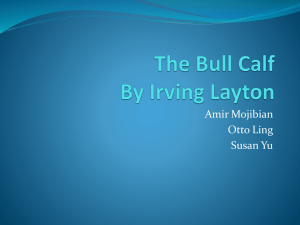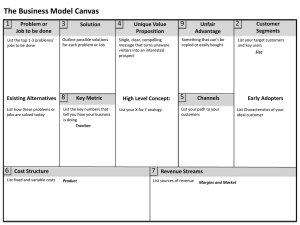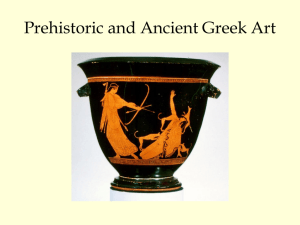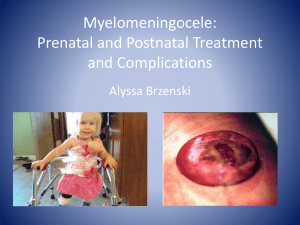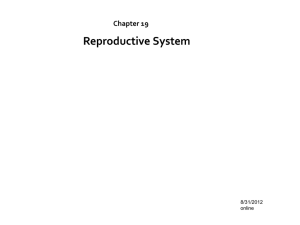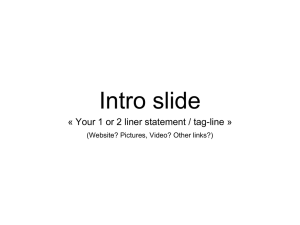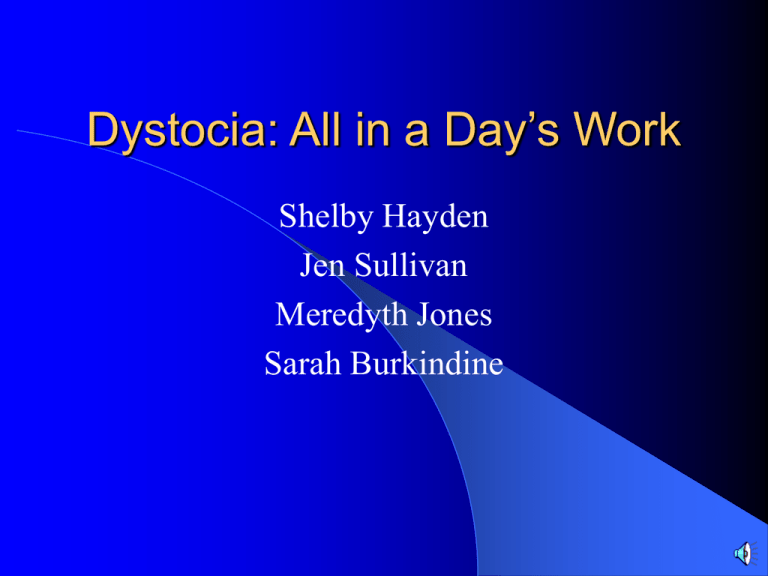
Dystocia: All in a Day’s Work
Shelby Hayden
Jen Sullivan
Meredyth Jones
Sarah Burkindine
Stage 1: initiation of
myometrial contractions
Stage 1: Visible signs
Seeks out isolation
Thick clear mucoid vaginal discharge
Signs of abdominal colic
Restlessness
Can last 2-6 hours
Stage 2: expulsion of the fetus
Entrance of the fetus into the birth canal
Stimulation of oxytocin release
Rupture of amniotic and allantoic sacs
Stage 2: expulsion of the fetus
Increasing uterine and abdominal
contractions
Stage 2 should last no longer than 1 hour
Stage 2: Visible signs
Rupture of the “water sacs”
Amniotic sac and feet are visible at the
vulva
Increasing frequency of abdominal
contractions
Expulsion of the fetus
Stage 3: expulsion of the
placenta
Detachment of chorionic villi from the
crypts on the maternal side of the placenta
Due to vasoconstriction
Usually occurs within 3-8 hours of
parturition
Fetal positioning
Presentation
Position
Posture
Fetal Presentation
Anterior, longitudinal
Posterior, longitudinal
Transverse ventral
Transverse dorsal
Fetal Position
Dorso-sacral
Dorso-pubic
Right and left dorso-ilial
Fetal Posture
Relation of the calf’s head, neck and limbs
to the body of the cow
Normal fetal positioning
Transverse Position
Causes of dystocia
Basic
Immediate
Causes of Dystocia
Hereditary
Nutritional (fat heifers, excessive fat in
pelvis)
Management (breeding large bulls to small
cows, breeding too soon after partrition)
Causes of Dystocia
Infectious (Brucella, Campylobacter, BVD,
Bluetongue, leptospirosis, corynebacterium,
Trichomonas, Listeria, IBR)
Traumatic (rupture of prepubic tendon,
uterine torsion)
Miscellaneous (hydrops, uterine inertia)
Immediate causes of dystocia
Fetal causes
Maternal causes
Fetal Causes
Size: breed, age of the dam, sire, sex
Abnormal: presentation, position, posture
Fetal Monsters: schistosomas reflexus,
perosomus elumbis
Schistosomus reflexus
Maternal Causes
Pelvic fractures
Breeding heifers too young
Hereditary or congenital hypoplasia of the
birth canal
Parturition Intervention Guidelines
Stage
I of labor > 6 hours and
cow/heifer has not begun to
abdominally press.
Stage
2 of labor > 2-3 hours and
progress is very slow or absent
Amniotic
sac has been visible for
2 hours and the calf has not hit the
ground
Dystocia Watch Intervals
< 3 hours intervals is required to determine
length of duration of the stages of
parturition.
Equipment required for
obstetrical exam
Twine or robe
Novasan or
betadine scrub
Bucket or bottle of
warm water
Sterile lube
Palpation sleeves
Obstetrical Equipment for Pulling a
Calf
Same equipment required for
obstetrical exam plus:
Calf Jack (Puller)
Cont. of obstetrical equipment for
calf pulling
Head
snare
Epidural Equipment
– 2 % lidocaine
– 6 cc syringe
– 18 gauge 1.5 inch needle
Obstetrical Exam
1.
Fill clean bucket with betadine or
novasan solution diluted with
warm water to either a “weak tea”
solution or a light blue solution
respectively.
2. Place obstetrical chains and
handles, tube of sterile lube and
head snare into the bucket.
Clean the perineal region with a
betadine or novasan scrub followed
by a clean warm water rinse.
3.
•
Minimum of 2- 3 separate scrub/rinse
cycles
4.
Put on 2 clean plastic OB sleeves.
5.
Lubricate both arms with sterile
OB lube
Examine the birth canal for
dilation and size of the pelvic
opening.
6)
•
Manually dilate the birth canal if needed
7.
Examine cervical dilation and
structures in the birth canal
8. Examine uterus and birth canal for
prior damage.
9. Evaluate position, presentation and
posture of the calf and/or calves.
Evaluate calf or calves viability
10.
•
•
•
•
•
Withdrawal reflex
Corneal/palpebral reflex
Suckle and tongue withdrawal
reflexes
Anal sphincter reflex
Heartbeat felt through chest wall or
umbilical artery pulse
Methods of Correcting
Dystocia
Live Fetus
Options:
Dead Fetus
Options:
– Mutation
– Mutation
– Forced Extraction
– Forced Extraction
– Cesarean Section
– Fetotomy
– Cesarean Section
Mutation
Repulsion:
Rotation:
– Moving from dorso-pubic or dorso-ilial to
dorso-sacral position
Version:
– Turning the fetus end-for end (i.e. on a
transverse axis)
Reposition
of Extremities
Minimum Goal of Mutation
Reposition the calf into a dorso-sacral
position
Calf’s front legs extended cranially and
hind legs extended caudally in
perspective to the calf’s body.
Guidelines for Mutation
1.
Abnormalities in presentation, position,
posture should be diagnosed and
corrected prior to attempting traction.
When the fetus is dead and
repositioning is difficult or dangerous,
other options should be considered
2.
•
•
Partial or complete fetotomy
Cesarean Section
3.
Maximum of 30 minutes of
mutation without progress
warrants
c-section or fetotomy.
Types of Mutation Dystocias
Retention of Front Limb
Retention of Rear Limb
Retention of the Head
Irregular Presentation or Position
– “Dog-sitter”
– Uterine Torsion
– Transverse Presentations
Types of Limb Mutation
Dystocias
Front limb
Hind Limb
– Flexed shoulder
– Hock flexion
posture
– Flexed carpal
posture
– Elbow lock posture
– Foot-nape posture
posture
– Hip flexion posture
Flexed Carpus manipulation
1.
Convert flexed leg to flexed carpus posture
by traction on the upper foreleg if the
shoulder is flexed.
2.
Apply simultaneous repulsion to the
carpus in an anterior-dorsolateral direction
and traction on the hoof in a medial and
posterior direction
Elbow Lock Posture
Occur when forelimbs are not fully
extended as they come into the pelvic inlet
Presentation:
– Tips of toes are even with the end of the calf’s
nose
Correction:
– Repulsion on the fetal trunk and simultaneous
alternating traction on the limbs
Flexed Hock Manipulation
1.
Convert the
flexed hip to a
flexed hock
posture
Apply hand
traction high on
the leg working
your way
distally until
the hock is
reached
2.
Place 1 hand on the hock while
simultaneously placing a second hand
over the hoof.
3.
Move the hoof posteriorly and medially
into the birth canal as repulsion is applied
in an anterior-lateral direction on the hock.
Lateral view
Caudal view
Dystocia due to Retention of
the Head
Lateral deviation
– Most common
Ventral deviation
Dorsal deviation
Vertex posture
– bride of nose is impacted against the brim of
the pelvis causing the poll to be presented
– Fetus is often dead
Head-Breast Posture
Correction of ventral deviation of the head
Procedure
1. Repel 1 forelimb to the flexed shoulder
posture
2. Bring the head up from beneath the body of
the fetus
3. Flexed shoulder is converted to normal
posture using the flexed carpal manipulation
Lateral Deviation of the Head
Correction of Lateral Deviation
of the Head
Repulsion of the shoulder, thorax, or brisket
with concurrent traction on the head
Sources for Traction on the Head:
– 2nd hand
– Jaw snare: beware of jaw fractures
– -head, jaw or orbital hooks
Irregular Presentation or
Position
“Dog-Sitter”
Uterine Torsion
Transverse Presentations
“Dog-Sitter”
Rear legs are
extended along
the abdomen of
the otherwise
normally
presented fetus
Correction of the “Dog-Sitter”
Only attempt mutation if the fetus is small
enough to allow palpation both hind limbs
during extraction.
– Allows for the hind legs to be repelled and
allows the uterus to be protected from the
hooves as the rear legs straighten out during
delivery.
– Otherwise, rear hooves may tear the uterus
as they extend behind the fetus.
Cont. Correction of “Dog-Sitter”
180 degree version to posterior presentation
and rotation to dorso-sacral position
Cesarean section
– Especially with oversized fetus
Fetotomy
– Impacted fetus in the birth canal
Uterine Torsion
Always examine uterus for torsion if fetus
appears to be presented in a dorso-ilial OR
dorso-pubic position.
Uterine Torsion Findings
Spiral folding of the birth canal
– Simulates incomplete dilatation of the cervix
Broad ligaments of the uterus are rotated
and stretches across the birth canal
– 1 on the upper and 1 on the lower surface
– Felt via Rectal Palpation.
Methods to Correct Uterine
Torsion
Shaffer
method (plank in the flank)
Rotate fetus in utero
Cesarean Section
Transverse Presentations
Correction of Transverse
Presentations
Mutation is usually not attempted especially
if presenting transverse dorsal.
– Rear legs sometimes perforate the uterus as
they straighten if delivery is attempted by
anterior presentation
Convert to posterior presentation, dorsosacral position
Cesarean Section
Monster Fetus
DO NOT
ATTEMPT TO
MUTATE OR
PULL
CESAREAN
SECTION IS
REQUIRED
Forced Extraction of a Fetus
Which one has already prepared for
prior to the initial obstetrical
examination
– i.e. obstetrical chains and hooks should
already be in the bucket of dilute betadine or
novasan solution.
Do not give an epidural anesthetic unless
it is absolutely necessary.
– Prevents dam from assisting delivery of the
calf
Forced Extraction in Anterior
Presentation
Placement of
obstetrical
chains
1)
•
Eyelets on the
dorsal surface of
the forefeet
2)
Traction on Fetus
Traction Procedure especially
if fetus is oversized
Unilateral traction is applied to the bottom
(most anteriorly located) forelimb until its
shoulder and elbow are past the pelvic inlet
– It can usually be felt when the shoulder passes
the ilium.
– Otherwise, assume that when the fetlock is ~10
cm (15 cm in larger breeds) outside of the
vulva, the shoulder has passed through the
pelvic inlet.
Cont. Traction of oversized
fetus (anterior presentation)
Full-force unilateral traction is than applied
to the top forelimb (hopefully by a 2nd
person)
– Extraction is usually is possible if the 2nd
shoulder also passes the ilium into the birth
canal
– If not, C-SECTION IS PROBABLY
REQUIRED.
Traction can be attempted with a calf jack
but do not exceed force of 2-3 strong men.
3)
Rotation of the Fetus
How to rotate the calf to avoid hiplock
Completion of Rotation
•Rotation of the fetus takes advantage of
the widest diameter of the pelvic inlet
If Hiplock occurs . . .
1.
2.
3.
Discontinue traction
Clean the mucus and membranes from the
calf’s nostrils
Stimulate breathing
–
–
Tickle the nostrils
Pour cold water over the head of the calf
4.
With hiplock apply traction
only when the cow presses
Continuous
traction is
generally
unproductive
Pelvic inlet
becomes
functionally larger
5. Apply traction caudally and
somewhat dorsally
This direction
of pull is
more
perpendicular
to the pelvic
inlet
6. Maintain rotation of the
calf’s pelvis in a dorso-ilial
position.
•Palpation along the back of the
calf is required to ensure that the
calf’s pelvis is rotated 60 to 90
degrees.
Forced Extraction in Posterior
Presentation
Rotate the calf into the dorso-ilial position
Apply OB chains to the hind legs in a
similar manner as the front legs
Apply traction in a caudal, slightly dorsal
direction to bring the calf’s hips through the
pelvic inlet.
Cont. Forced Extraction in Posterior
Presentation
Rotate
the calf back into a dorso-sacral
position once the rear quarters have
passed the pelvic inlet
Apply
slightly caudal, ventral traction
Calf Jack
Can be used with
either posterior or
anterior
presentation
NEVER APPLY
MORE FORCE
THAN WHAT 2-3
STRONG MEN
CAN APPLY
Cesarean Section
Approaches:
– High left flank
– Low left flank
– Left paramedian
– High right flank
– Low right flank
– Right paramedian
– Ventral Midline
Fetotomy
Should only be performed in the dead fetus
Fetotomy Equipment
Fetotome
Wire Threader
Wire saw handles
Wire introducer
Krey Hook
OB chain
Lubicant
Epidural equipment
Injury to the Calf
Asphyxiation and Anoxia
Rupture or impaction of the umbilicus during
manipulation necessitates rapid extraction to
prevent anoxia and potential brain damage
Complications more frequently associated
with posterior presentation
Femoral Nerve Paralysis
Often associated with
prolonged hiplock
during extraction
Nerve Damage
Fractures
Fracture of the mandible
due to inappropriate use
of obstetrical chains
Fractures
Placement of obstetrical
chains with one loop over
the fetlock and a half-hitch
around the pastern will
better distribute traction and
prevent injury to fetal limbs
Fractures
Excessive traction may
also result in fractures
of the pelvis or ribs, as
well as injury to the
joints and spine
Complications Associated with
Posterior Presentation
Pulmonary hemorrhage, diaphragmatic
hernia, and liver rupture may be caused by
excessive traction on the fetus in posterior
presentation
Injury to the Dam
Calving Paralysis
Paresis or paralysis
of the cow
Damage to peroneal
and obturator nerves
May be caused by
prolonged hiplock or
excessive force used
in its resolve
Retained Placenta
Direct association with abortion,
twinning, dystocia, cesarean-section,
and fetotomy.
Uterine Prolapse
Associated with
dystocia and irritation
of the external birth
canal
Complicated by
environmental insult—
freezing, drying,
severe laceration
Trauma to the Birth Canal
Tears and lacerations:
– Vulvar, vaginal and cervical tears, recto-vaginal
fistula or perineal laceration
– Forelimbs may be forced through the dorsum of
the birth canal
Hematoma
Vaginal necrosis
Uterine Ruptures or Tears
Associated with prolonged dystocia, uterine
torsion, and excessive repulsion or rough
manipulation
Tears most commonly occur in the ventral
uterine wall
@#$*%&!!
Dam number 1025
Saturday, April 6: calf presents breech, calving
difficulty 5 and 8, calf does not survive extraction
Monday, April 8: dam found dead, presented for
necropsy
Peritonitis
Examination of
the abdominal
cavity reveals
a considerable
volume of
bloody fluid
and fibrin
Petechiation of the Heart
Indicative of an
acute/agonal incident
or a septic insult
Dorsal Uterine Tear
Full thickness,
approximately six
inches long
Ventral Uterine Tear
Partial thickness,
approximately three
inches long with
associate mucosal/
sub-mucosal
hemorrhage
Fetal Lungs
Appearance of the
lungs indicated the
calf had taken a breath
@#$*%&!!
Economic Implications of Dystocia
Things to consider:
-Dam Value
-Live Calf Value
-Cost of
Veterinary
Intervention
Dam Value
Dairy cows (Holstein)
- Replacement of Mature Milking Cow:
$1200-1500
- Replacement of Springing Heifer:
$1800-2500
- Lactation and Genetic Potential
Dam Value
Beef Cows
Purchase of Replacement Heifer: $850-900
Rearing of Replacement Heifer: $750-800
Seedstock Genetics
Live Calf Value
•Dairy Calves
- 1 day old heifer
calf: $500-700
- 1 day old bull
calf: $100-150
Live Calf Value
•Beef Calves
- Feeder Futures for January, 2003
- $79/cwt x 700# = $553
Even if you can’t save baby…
•Dairy Cow value post-calving
- Lactation: 18,000# x $0.87/# = $15,666
- This does not include cost of lactation
- Salvage: $54.00/cwt x 1000# = $540
- Rebreed
Even if you can’t save baby…
•Beef cow value post-calving:
- Raise orphaned or twin calf; Rebreed
- Salvage: $60/cwt x 900# = $540
Producer Cost for Caesarean
Section
•Survey of veterinarians
- Average charge for on-farm dystocia
ending in Caesarean section
- $258.92
What is the bottom line?
•Dairy Producer:
-Heifer + Calf Alive = $2300
Plus Lactation ($15,000) and Genetics
-Heifer Alive = $1800
Plus Lactation ($15,000) and Genetics
-Cost of Caesarean: $260
11% of value of both at that time
What is the bottom line?
•Commercial Beef Producer:
- Heifer and Calf Alive: $1403
- Heifer Alive: $850
- Cost of Caesarean: $260
-18% value of both
Conclusion
•Producers should make dystocia management
decisions before breeding occurs
•When a dystocia presents itself , make your
decisions based on what is best for the
herd’s production goals
•If you need to intervene, do so with caution
and think ahead about the effects of your
actions on the pair’s future production
Thank you to all
the faculty and
staff of GPVEC
for contributing
to our education.
The End
Any questions?

